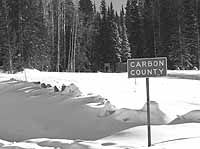| A Carbon County boundary sign stands in front of trees and a trail that winds its way through the Manti LaSal National Forest in the mountains above Scofield. The forest service will be holding a meeting on a process they use to manage areas like this on Nov. 1 in Castle Dale at the Museum of the San Rafael. |
While local residents have been digesting and sending comments to the the Bureau of Land Management about their recent release of their resource management plan, another federal document has been released that Carbon County citizens can review as well.
The United States Forest Service has released the preliminary analysis of the management situation on the Manti-LaSal. The 110-page document “establishes general management directions for lands administered by the Manti LaSal National Forest,” according to the federal agency
The management act requires national forests to develop a land and resource management plan (LRMP) to update or revise their plan every 15 years and that is what the agency is in the middle of at the present time.
Last summer and spring as well in 2003, public meetings were held for identification purposes of areas where citizens may have had concerns.
The document is the first step in revising the LRMP.
On Oct. 22, the forest administration placed a notice of intent to prepare an environmental impact statement in the Federal Register.
According to recent meetings and the federal agency’s documen, six decisions must be made when reviewing a forest plan.
•First, the agency must look at the goals and objectives of the administered area.
•Second, officials need to set standards for the forest that are applied across the entire area.
•Third, officials need to identify suitable uses for the forest.
•Fourth, the agency must establish monitoring and evaluation requirements for uses and impacts.
•Fifth, the forest administration needs to make recommendations to Congress concerning areas that are eligible for wilderness designation.
•Last, officials must identify lands not suited for timber production.
Under the scope of the revision plan, the “forest supervisor shall determine the major public issues, management concerns, and resource use and development opportunities to be addressed in the planning process.”
The Manti-LaSal National Forest has identified a number of areas that need increased study.
The first is timber suitability. In the preliminary survey, officials determined that lands identified as not suited for timber production must be re-examined at least every 10 years.
Next are the possible wilderness areas, where they consider all roadless areas for possible inclusion in the National Wilderness Preservation System.
The forest administration must also look at Wild and Scenic River designations.
The federal officials must document in the plan rivers that are potentially eligible for that designation.
Finally they must look at areas in the forest that may need reevaluation to assess if changes in how those lands are administered is in order.
This document and the following LRMP affects a number of areas in Utah and Colorado. In Utah, Carbon, Emery, Grand, Juab, San Juan, Utah, Sevier and Sanpete counties are affected. In Colorado, Montrose and Mesa counties are involved.
A series of open houses will be held to discuss the notice of intent and the AMS in the next two weeks. The closest meeting for Carbon residents will be held at the Museum of the San Rafael, 96 North 100 East in Castle Dale on Nov. 1 from 4-7 p.m.
For additional information on the AMS, Carbon County residents with Internet access may visit the agency’s website at www.fs.fed.us/r4/mantilasal/projects/.
Residents may also call the agency’s local office at 637 2817.

